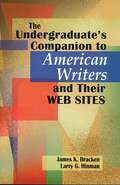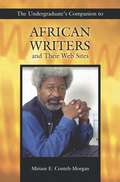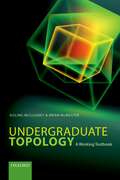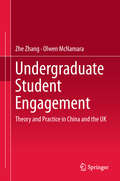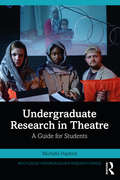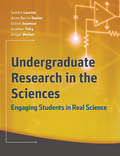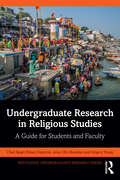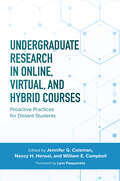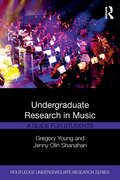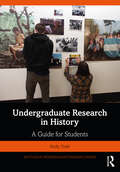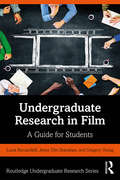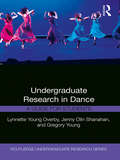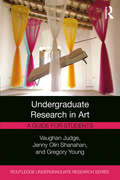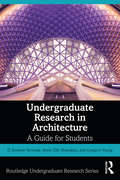- Table View
- List View
The Undergraduate's Companion to American Writers and Their Web Sites (Author Research Series)
by Larry G. HinmanAn outstanding research guide for undergraduate students of American literature, this best-selling book is essential when it comes to researching American authors. Bracken and Hinman identify and describe the best and most current sources, both in print and online, for nearly 300 American writers whose works are included in the most frequently used literary anthologies. Students will know exactly what information is available and where to find it.
The Undergraduate's Companion to African Writers and Their Web Sites (Author Research Series)
by Miriam E. Conteh-MorganNow a firmly established part of world literature course offerings in many general education curricula, African literature is no longer housed exclusively with African Studies programs, and is often studied in English, French, Portuguese, Women's Studies, and Comparative Studies departments. This book helps fill the great need for research materials on this topic, presenting the best resources available for 300 African writers. These writers have been carefully selected to include both well-known writers and those less commonly studied yet highly influential. They are drawn from both the Sub-Sahara and the Maghreb, the major geographical regions of Africa.The study of Africa was introduced into the curriculum of institutions of higher learning in the United States in the 1960s, when the Black Consciousness movement in the United States and the Cold War and decolonization movements in Africa created a need for the systematic study of other regions of the world. Between 1986 and 1991, three Africans won Nobel literature prizes: Soyinka, Mahfouz, and Gordimer, and the visibility of African writers increased. They are now a firmly established part of world literature courses in many general education curricula throughout North America. African Writers is meant to serve as a resource for introductory material on 300 writers from 39 countries. These writers were selected on the basis on two criteria: that there is material on them in an easily available reference work; and that there is some information of research value on free Web sites. Each writer is from the late-19th or 20th century, with the notable exception of Olaudah Equiano, an 18th-century African whose slave narrative is generally considered the first work of African literature. All entries are annotated.
Undergraduate Topology: A Working Textbook
by Aisling McCluskey Brian McMasterThis textbook offers an accessible, modern introduction at undergraduate level to an area known variously as general topology, point-set topology or analytic topology with a particular focus on helping students to build theory for themselves. It is the result of several years of the authors' combined university teaching experience stimulated by sustained interest in advanced mathematical thinking and learning, alongside established research careers in analytic topology. Point-set topology is a discipline that needs relatively little background knowledge, but sufficient determination to grasp ideas precisely and to argue with straight and careful logic. Research and long experience in undergraduate mathematics education suggests that an optimal way to learn such a subject is to teach it to yourself, pro-actively, by guided reading of brief skeleton notes and by doing your own spadework to fill in the details and to flesh out the examples. This text will facilitate such an approach for those learners who opt to do it this way and for those instructors who would like to encourage this so-called 'Moore approach', even for a modest segment of the teaching term or for part of the class. In reality, most students simply do not have the combination of time, background and motivation needed to implement such a plan fully. The accessibility, flexibility and completeness of this text enable it to be used equally effectively for more conventional instructor-led courses. Critically, it furnishes a rich variety of exercises and examples, many of which have specimen solutions, through which to gain in confidence and competence.
Undergraduate Topology: A Working Textbook
by Aisling McCluskey Brian McMasterThis textbook offers an accessible, modern introduction at undergraduate level to an area known variously as general topology, point-set topology or analytic topology with a particular focus on helping students to build theory for themselves. It is the result of several years of the authors' combined university teaching experience stimulated by sustained interest in advanced mathematical thinking and learning, alongside established research careers in analytic topology. Point-set topology is a discipline that needs relatively little background knowledge, but sufficient determination to grasp ideas precisely and to argue with straight and careful logic. Research and long experience in undergraduate mathematics education suggests that an optimal way to learn such a subject is to teach it to yourself, pro-actively, by guided reading of brief skeleton notes and by doing your own spadework to fill in the details and to flesh out the examples. This text will facilitate such an approach for those learners who opt to do it this way and for those instructors who would like to encourage this so-called 'Moore approach', even for a modest segment of the teaching term or for part of the class. In reality, most students simply do not have the combination of time, background and motivation needed to implement such a plan fully. The accessibility, flexibility and completeness of this text enable it to be used equally effectively for more conventional instructor-led courses. Critically, it furnishes a rich variety of exercises and examples, many of which have specimen solutions, through which to gain in confidence and competence.
Undergraduate Student Engagement: Theory and Practice in China and the UK
by Zhe Zhang Olwen McNamaraThis book focuses on undergraduate student engagement in China and the UK. It offers an innovative perspective on this aspect, which, although pervasive, is not always acknowledged by its users to be complex and multidimensional in nature, firmly rooted in cultural, social and disciplinary norms, and difficult to measure. Competition within the global higher education market has become increasingly intense amongst universities; and the higher education sector in China, currently the largest source of international students, is beginning to compete strongly for its home market. Against this consumerist background, student engagement, with its close relation to positive learning outcomes, is increasingly receiving attention from higher education managers and researchers who seek to improve the quality of their ‘products’.The research study on which the book is based draws on three courses, two in China and one in the UK. It offers a binary perspective across two very different cultures (Western and Confucian) and two very different subject areas (Chinese language and mathematics). The study employs a mixed-methods design and develops a conceptual framework derived from statistical and thematic analysis. An original theoretical lens, combining a bioecological perspective (Bronfenbrenner) and a sociocultural one (Holland et al.’s Figured Worlds), adds further interpretive power to help understand the construct of student engagement.
Undergraduate Research in Theatre: A Guide for Students (Routledge Undergraduate Research Series)
by Michelle HayfordUndergraduate Research in Theatre: A Guide for Students supplies tools for scaffolding research skills alongside examples of undergraduate research in theatre and performance scholarship. The book begins with an overview of the necessity of framing theatre as undergraduate research and responding to calls for revolutionizing the discipline toward greater equity, diversity, and inclusion. Dedicated chapters for the research, skills, and methods employed by each theatre area follow: scripted theatre; devised and new works; applied theatre; scenic, costume, sound, and lighting design; and theatre theory and interdisciplinary studies. Throughout the book, undergraduate research activities are demonstrated by 36 case studies authored by undergraduates from six countries about diverse areas of theatre study. Suitable for both professors and students, Undergraduate Research in Theatre is an ideal resource for any course that has an opportunity for the creation of new knowledge or as an essential interdisciplinary connection between theatre, performance, and other disciplines.
Undergraduate Research in Theatre: A Guide for Students (Routledge Undergraduate Research Series)
by Michelle HayfordUndergraduate Research in Theatre: A Guide for Students supplies tools for scaffolding research skills alongside examples of undergraduate research in theatre and performance scholarship. The book begins with an overview of the necessity of framing theatre as undergraduate research and responding to calls for revolutionizing the discipline toward greater equity, diversity, and inclusion. Dedicated chapters for the research, skills, and methods employed by each theatre area follow: scripted theatre; devised and new works; applied theatre; scenic, costume, sound, and lighting design; and theatre theory and interdisciplinary studies. Throughout the book, undergraduate research activities are demonstrated by 36 case studies authored by undergraduates from six countries about diverse areas of theatre study. Suitable for both professors and students, Undergraduate Research in Theatre is an ideal resource for any course that has an opportunity for the creation of new knowledge or as an essential interdisciplinary connection between theatre, performance, and other disciplines.
Undergraduate Research in the Sciences: Engaging Students in Real Science
by Sandra Laursen Anne-Barrie Hunter Elaine Seymour Heather Thiry Ginger MeltonUndergraduate research enhances the learning experience of students in science, technology, engineering, and mathematics. Undergraduate Research in the Sciences offers a groundbreaking and practical research-based book on the topic. This comprehensive resource addresses how undergraduate research benefits undergraduate participants, including those populations that are underrepresented in the sciences; compares its benefits with other types of educational activities and experiences; and assesses its long-term value to students and faculty as both a scholarly and educational endeavor. In laying out the processes by which these benefits are achieved, this important book can assist faculty and program directors with practical guidance for design and evaluation of both new and existing undergraduate research programs. Praise for Undergraduate Research in the Sciences "This meticulous, definitive study of the effects of working with a faculty member on research as an undergraduate confirms the overall value of the experience by taking us deep into the minds and actions of participants—both faculty and students. As a result we now have many more compelling reasons to get more students involved with research mentors and ways to optimize the benefits for all parties."—George D. Kuh, Chancellor's Professor and director, Indiana University Center for Postsecondary Research "This timely book offers a unique, comprehensive analysis of undergraduate research in the sciences, based on the voices of college students and faculty mentors who have participated in these voyages of discovery. As our nation struggles to train more scientists, this book will be a valuable resource for designing undergraduate research experiences that can build our country's capacity for discovery and innovation."—Arthur B. Ellis, Vice Chancellor for Research, University of California, San Diego "The text is written in a lucid and engaging style and will be a valuable guide to policymakers, academic administrators, and faculty members who want to find ways to engage undergraduates in the 'real work' of investigation."—Judith A. Ramaley, president, Winona State University "This book is a 'must-read' for anyone who directs undergraduates in research. It presents an impressive and rigorous body of work that brings fresh insights into the field of undergraduate research. The next generation of scientists will benefit greatly from the findings and recommendations!"—Jo Handelsman, Howard Hughes Medical Institute Professor, Yale University
Undergraduate Research in the Sciences: Engaging Students in Real Science
by Sandra Laursen Anne-Barrie Hunter Elaine Seymour Heather Thiry Ginger MeltonUndergraduate research enhances the learning experience of students in science, technology, engineering, and mathematics. Undergraduate Research in the Sciences offers a groundbreaking and practical research-based book on the topic. This comprehensive resource addresses how undergraduate research benefits undergraduate participants, including those populations that are underrepresented in the sciences; compares its benefits with other types of educational activities and experiences; and assesses its long-term value to students and faculty as both a scholarly and educational endeavor. In laying out the processes by which these benefits are achieved, this important book can assist faculty and program directors with practical guidance for design and evaluation of both new and existing undergraduate research programs. Praise for Undergraduate Research in the Sciences "This meticulous, definitive study of the effects of working with a faculty member on research as an undergraduate confirms the overall value of the experience by taking us deep into the minds and actions of participants—both faculty and students. As a result we now have many more compelling reasons to get more students involved with research mentors and ways to optimize the benefits for all parties."—George D. Kuh, Chancellor's Professor and director, Indiana University Center for Postsecondary Research "This timely book offers a unique, comprehensive analysis of undergraduate research in the sciences, based on the voices of college students and faculty mentors who have participated in these voyages of discovery. As our nation struggles to train more scientists, this book will be a valuable resource for designing undergraduate research experiences that can build our country's capacity for discovery and innovation."—Arthur B. Ellis, Vice Chancellor for Research, University of California, San Diego "The text is written in a lucid and engaging style and will be a valuable guide to policymakers, academic administrators, and faculty members who want to find ways to engage undergraduates in the 'real work' of investigation."—Judith A. Ramaley, president, Winona State University "This book is a 'must-read' for anyone who directs undergraduates in research. It presents an impressive and rigorous body of work that brings fresh insights into the field of undergraduate research. The next generation of scientists will benefit greatly from the findings and recommendations!"—Jo Handelsman, Howard Hughes Medical Institute Professor, Yale University
Undergraduate Research in Religious Studies: A Guide for Students and Faculty (Routledge Undergraduate Research Series)
by Ruben Dupertuis Chad Spigel Jenny Olin Shanahan Gregory YoungUndergraduate Research in Religious Studies provides students and faculty with an invaluable guide to conducting research projects across all areas in the study of religion. With an emphasis on student-faculty collaboration, this concise book addresses the key areas, methods, and practical issues to inform the practice of original undergraduate research across a wide range of subdisciplines.In fourteen short chapters, the authors lay out the stages of the research process and different research methodologies; discuss approaches, examples, and ethical issues particular to religious studies; and address the unique value and challenges of collaborative research with undergraduate students, including case studies of student-faculty collaboration. Designed to be utilized by students and faculty as both a textbook and reference, this book offers an essential resource for all those engaging in or leading undergraduate research across religious studies.
Undergraduate Research in Religious Studies: A Guide for Students and Faculty (Routledge Undergraduate Research Series)
by Ruben Dupertuis Chad Spigel Jenny Olin Shanahan Gregory YoungUndergraduate Research in Religious Studies provides students and faculty with an invaluable guide to conducting research projects across all areas in the study of religion. With an emphasis on student-faculty collaboration, this concise book addresses the key areas, methods, and practical issues to inform the practice of original undergraduate research across a wide range of subdisciplines.In fourteen short chapters, the authors lay out the stages of the research process and different research methodologies; discuss approaches, examples, and ethical issues particular to religious studies; and address the unique value and challenges of collaborative research with undergraduate students, including case studies of student-faculty collaboration. Designed to be utilized by students and faculty as both a textbook and reference, this book offers an essential resource for all those engaging in or leading undergraduate research across religious studies.
Undergraduate Research in Online, Virtual, and Hybrid Courses: Proactive Practices for Distant Students
by Jennifer G. Coleman Nancy H. Hensel Wm. E. CampbellCo-published with and With the growing interest in undergraduate research as a high-impact practice, and the recognition that college education is increasingly moving online, this book – the first to do so – provides a framework, guidance from pioneering practitioners, and a range of examples across disciplines on how to engage remote students in research.Two foundational chapters set the scene. For those new to incorporating undergraduate research in their courses, the opening chapter provides an introduction to its evolution and practice, and reviews the evidence of its benefits for students, faculty, and institutions. The second addresses the benefit that undergraduate research can bring to online learning and provides an overview of the ways research can be incorporated into online and virtual courses to meet the course and student learning objectives. The remaining chapters illustrate implementation of undergraduate research in courses across many disciplines. They address thematic issues related to the work and its effects on students, such as transitioning them from users of, to active participants in, research; and consideration of the technological tools needed to support students in a virtual environment. The contributors, some of whom have been implementing these practices for some years, offer important insights and expertise.While the examples range across the behavioral sciences, business, education, the health professions, the humanities, social sciences, and STEM, readers will find much of value and inspiration from reading the chapters beyond their disciplines.
Undergraduate Research in Online, Virtual, and Hybrid Courses: Proactive Practices for Distant Students
Co-published with and With the growing interest in undergraduate research as a high-impact practice, and the recognition that college education is increasingly moving online, this book – the first to do so – provides a framework, guidance from pioneering practitioners, and a range of examples across disciplines on how to engage remote students in research.Two foundational chapters set the scene. For those new to incorporating undergraduate research in their courses, the opening chapter provides an introduction to its evolution and practice, and reviews the evidence of its benefits for students, faculty, and institutions. The second addresses the benefit that undergraduate research can bring to online learning and provides an overview of the ways research can be incorporated into online and virtual courses to meet the course and student learning objectives. The remaining chapters illustrate implementation of undergraduate research in courses across many disciplines. They address thematic issues related to the work and its effects on students, such as transitioning them from users of, to active participants in, research; and consideration of the technological tools needed to support students in a virtual environment. The contributors, some of whom have been implementing these practices for some years, offer important insights and expertise.While the examples range across the behavioral sciences, business, education, the health professions, the humanities, social sciences, and STEM, readers will find much of value and inspiration from reading the chapters beyond their disciplines.
Undergraduate Research in Music: A Guide for Students (Routledge Undergraduate Research Series)
by Jenny Olin Shanahan Gregory YoungUndergraduate Research in Music: A Guide for Students supplies tools for scaffolding research skills, with examples of undergraduate research activities and case studies on projects in the various areas of music study. Undergraduate research has become a common degree requirement in some disciplines and is growing rapidly. Many undergraduate activities in music have components that could be combined into compelling undergraduate research projects, either in the required curriculum, as part of existing courses, or in capstone courses centered on undergraduate research. The book begins with an overview chapter, followed by the seven chapters on research skills, including literature reviews, choosing topics, formulating questions, citing sources, disseminating results, and working with data and human subjects. A wide variety of musical subdisciplines follow in Chapters 9–18, with sample project ideas from each, as well as undergraduate research conference abstracts. The final chapter is an annotated guide to online resources that students can access and readily operate. Each chapter opens with inspiring quotations, and wraps up with applicable discussion questions. Professors and students can use Undergraduate Research in Music: A Guide for Students as a text or a reference book in any course that has a significant opportunity for the creation of knowledge or art, within the discipline of music or in connecting music with other disciplines.
Undergraduate Research in Music: A Guide for Students (Routledge Undergraduate Research Series)
by Jenny Olin Shanahan Gregory YoungUndergraduate Research in Music: A Guide for Students supplies tools for scaffolding research skills, with examples of undergraduate research activities and case studies on projects in the various areas of music study. Undergraduate research has become a common degree requirement in some disciplines and is growing rapidly. Many undergraduate activities in music have components that could be combined into compelling undergraduate research projects, either in the required curriculum, as part of existing courses, or in capstone courses centered on undergraduate research. The book begins with an overview chapter, followed by the seven chapters on research skills, including literature reviews, choosing topics, formulating questions, citing sources, disseminating results, and working with data and human subjects. A wide variety of musical subdisciplines follow in Chapters 9–18, with sample project ideas from each, as well as undergraduate research conference abstracts. The final chapter is an annotated guide to online resources that students can access and readily operate. Each chapter opens with inspiring quotations, and wraps up with applicable discussion questions. Professors and students can use Undergraduate Research in Music: A Guide for Students as a text or a reference book in any course that has a significant opportunity for the creation of knowledge or art, within the discipline of music or in connecting music with other disciplines.
Undergraduate Research in History: A Guide for Students (Routledge Undergraduate Research Series)
by Molly ToddUndergraduate Research in History offers a blend of theory and practice for undergraduate researchers in history, relevant to new routines of the digital age. Explaining how research conducted by undergraduate students fits into the broader contexts of the discipline of history and the expanding realm of undergraduate research, this book presents the major phases of substantive research projects, and offers practical advice for work in specific historical areas as well as in interdisciplinary projects. The volume addresses key issues facing researchers, including finding relevant sources, funding research projects, and sharing results with diverse audiences. Supported by dozens of examples of real-world undergraduate research projects, this book is an indispensable reference for any student embarking on historical research and for professors guiding and collaborating with undergraduate researchers.
Undergraduate Research in History: A Guide for Students (Routledge Undergraduate Research Series)
by Molly ToddUndergraduate Research in History offers a blend of theory and practice for undergraduate researchers in history, relevant to new routines of the digital age. Explaining how research conducted by undergraduate students fits into the broader contexts of the discipline of history and the expanding realm of undergraduate research, this book presents the major phases of substantive research projects, and offers practical advice for work in specific historical areas as well as in interdisciplinary projects. The volume addresses key issues facing researchers, including finding relevant sources, funding research projects, and sharing results with diverse audiences. Supported by dozens of examples of real-world undergraduate research projects, this book is an indispensable reference for any student embarking on historical research and for professors guiding and collaborating with undergraduate researchers.
Undergraduate Research in Film: A Guide for Students (Routledge Undergraduate Research Series)
by Lucia Ricciardelli Jenny Olin Shanahan Gregory YoungUndergraduate Research in Film: A Guide for Students supplies tools for building research skills, with examples of undergraduate research activities and case studies on projects in the various areas in the study of film, film theory, film production, history of film, and interdisciplinary projects. Professors and students can use it as a text and/or a reference book. Essentially, what makes this volume unique is that it brings together examples of film projects and film studies courses within the framework of research skills. Following an overview chapter, the next seven chapters cover research skills including writing literature reviews, choosing topics and formulating questions,working with human subjects, collecting and analyzing data, citing sources and disseminating results. A wide variety of sub-disciplines follow in chapters 9-16 with sample project ideas from each, as well as undergraduate research conference abstracts. The final chapter is an annotated guide to online resources. All chapters begin with inspiring quotations and end with relevant discussion questions.
Undergraduate Research in Film: A Guide for Students (Routledge Undergraduate Research Series)
by Lucia Ricciardelli Jenny Olin Shanahan Gregory YoungUndergraduate Research in Film: A Guide for Students supplies tools for building research skills, with examples of undergraduate research activities and case studies on projects in the various areas in the study of film, film theory, film production, history of film, and interdisciplinary projects. Professors and students can use it as a text and/or a reference book. Essentially, what makes this volume unique is that it brings together examples of film projects and film studies courses within the framework of research skills. Following an overview chapter, the next seven chapters cover research skills including writing literature reviews, choosing topics and formulating questions,working with human subjects, collecting and analyzing data, citing sources and disseminating results. A wide variety of sub-disciplines follow in chapters 9-16 with sample project ideas from each, as well as undergraduate research conference abstracts. The final chapter is an annotated guide to online resources. All chapters begin with inspiring quotations and end with relevant discussion questions.
Undergraduate Research in Dance: A Guide for Students (Routledge Undergraduate Research Series)
by Lynnette Young Overby Jenny Olin Shanahan Gregory YoungUndergraduate Research in Dance: A Guide for Students supplies tools for scaffolding research skills alongside examples of undergraduate research in dance scholarship. Dance can be studied as an expressive embodied art form with physical, cognitive, and affective domains, and as an integral part of society, history, and vast areas of interdisciplinary content. To this end, the guidance provided by this book will equip future dance professionals with the means to move the field of dance forward. Chapters 1–9 guide students through the fundamentals of research methods, providing a foundation to help students get started in understanding research protocols and processes. Students will learn skills such as how to choose a research topic, refine research questions, conduct literature reviews, cite sources, synthesize and analyze data, develop conclusions and results, and present their findings. Chapters 10–19 detail forms of undergraduate research in a rich diversity of fields within dance that are taught in many collegiate dance programs including dance therapy, history, science, psychology, education, and technology, in addition to public scholarship, choreography, and interdisciplinary topics. The book also includes a final chapter which provides annotated online resources, and many of its chapters are supported by examples of abstracts of capstone projects, senior theses, and conference presentations by undergraduate researchers across the United States. Suitable for both professors and students, Undergraduate Research in Dance is an ideal reference book for any course that has a significant opportunity for the creation of new knowledge, or as an essential interdisciplinary connection between dance and other disciplines.
Undergraduate Research in Dance: A Guide for Students (Routledge Undergraduate Research Series)
by Lynnette Young Overby Jenny Olin Shanahan Gregory YoungUndergraduate Research in Dance: A Guide for Students supplies tools for scaffolding research skills alongside examples of undergraduate research in dance scholarship. Dance can be studied as an expressive embodied art form with physical, cognitive, and affective domains, and as an integral part of society, history, and vast areas of interdisciplinary content. To this end, the guidance provided by this book will equip future dance professionals with the means to move the field of dance forward. Chapters 1–9 guide students through the fundamentals of research methods, providing a foundation to help students get started in understanding research protocols and processes. Students will learn skills such as how to choose a research topic, refine research questions, conduct literature reviews, cite sources, synthesize and analyze data, develop conclusions and results, and present their findings. Chapters 10–19 detail forms of undergraduate research in a rich diversity of fields within dance that are taught in many collegiate dance programs including dance therapy, history, science, psychology, education, and technology, in addition to public scholarship, choreography, and interdisciplinary topics. The book also includes a final chapter which provides annotated online resources, and many of its chapters are supported by examples of abstracts of capstone projects, senior theses, and conference presentations by undergraduate researchers across the United States. Suitable for both professors and students, Undergraduate Research in Dance is an ideal reference book for any course that has a significant opportunity for the creation of new knowledge, or as an essential interdisciplinary connection between dance and other disciplines.
Undergraduate Research in Art: A Guide for Students (Routledge Undergraduate Research Series)
by Vaughan Judge Jenny Olin Shanahan Gregory YoungUndergraduate Research in Art: A Guide for Students supplies tools for scaffolding research skills, with examples of undergraduate research activities and case studies on projects in the various areas of the study of art—from art history, art education, and fine art therapy, to studio art, graphic design, and digital media. Although art degree programs don’t always call it research, many undergraduate activities in art have components that could be combined into comprehensive projects. The book begins with an overview chapter, followed by seven chapters on research skills, including literature reviews, choosing topics, formulating questions, citing sources, disseminating results, and working with data and human subjects. A wide variety of subdisciplines follow in Chapters 9 through 18, with sample project ideas from each, as well as undergraduate research conference abstracts. The final chapter is an annotated guide to online resources that students can access and readily operate. Each chapter opens with inspiring quotations, and wraps up with applicable discussion questions. Professors and students can use Undergraduate Research in Art as a text or a reference book.
Undergraduate Research in Art: A Guide for Students (Routledge Undergraduate Research Series)
by Vaughan Judge Jenny Olin Shanahan Gregory YoungUndergraduate Research in Art: A Guide for Students supplies tools for scaffolding research skills, with examples of undergraduate research activities and case studies on projects in the various areas of the study of art—from art history, art education, and fine art therapy, to studio art, graphic design, and digital media. Although art degree programs don’t always call it research, many undergraduate activities in art have components that could be combined into comprehensive projects. The book begins with an overview chapter, followed by seven chapters on research skills, including literature reviews, choosing topics, formulating questions, citing sources, disseminating results, and working with data and human subjects. A wide variety of subdisciplines follow in Chapters 9 through 18, with sample project ideas from each, as well as undergraduate research conference abstracts. The final chapter is an annotated guide to online resources that students can access and readily operate. Each chapter opens with inspiring quotations, and wraps up with applicable discussion questions. Professors and students can use Undergraduate Research in Art as a text or a reference book.
Undergraduate Research in Architecture: A Guide for Students (Routledge Undergraduate Research Series)
by D. Andrew Vernooy Jenny Olin Shanahan Gregory YoungUndergraduate Research in Architecture: A Guide for Students supplies tools for scaffolding research skills, with examples of undergraduate research activities and case studies on projects in the various areas of architecture study. Undergraduate research has become a common degree requirement in some disciplines and is growing rapidly. Many undergraduate activities in music have components that could be combined into compelling undergraduate research projects, either in the required curriculum, as part of existing courses, or in capstone courses centered on undergraduate research.Following an overview chapter, the next seven chapters cover research skills including literature reviews, choosing topics, formulating questions, citing sources, disseminating results, and working with data and human subjects. A wide variety of sub-disciplines follow in the remaining chapters, with sample project ideas from each as well as undergraduate research conference abstracts. The final chapter is an annotated guide to online resources. Included are some inspirational quotations concerning architecture’s commitment to research, and some examples of professional research that support the focus of the chapter. All chapters end with relevant questions for discussion.
Undergraduate Research in Architecture: A Guide for Students (Routledge Undergraduate Research Series)
by D. Andrew Vernooy Jenny Olin Shanahan Gregory YoungUndergraduate Research in Architecture: A Guide for Students supplies tools for scaffolding research skills, with examples of undergraduate research activities and case studies on projects in the various areas of architecture study. Undergraduate research has become a common degree requirement in some disciplines and is growing rapidly. Many undergraduate activities in music have components that could be combined into compelling undergraduate research projects, either in the required curriculum, as part of existing courses, or in capstone courses centered on undergraduate research.Following an overview chapter, the next seven chapters cover research skills including literature reviews, choosing topics, formulating questions, citing sources, disseminating results, and working with data and human subjects. A wide variety of sub-disciplines follow in the remaining chapters, with sample project ideas from each as well as undergraduate research conference abstracts. The final chapter is an annotated guide to online resources. Included are some inspirational quotations concerning architecture’s commitment to research, and some examples of professional research that support the focus of the chapter. All chapters end with relevant questions for discussion.
